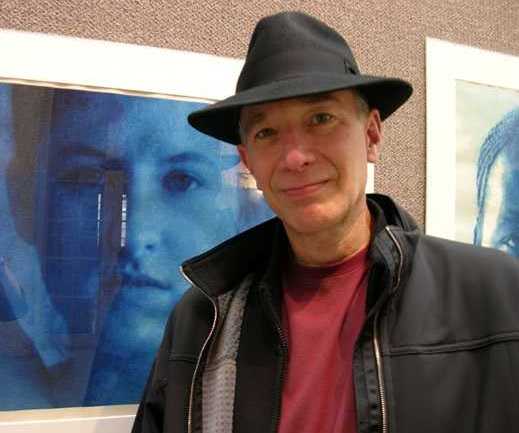Who is Mike Lyon?
Recently we were contacted by a Kansas City artist and printmaker by the name of Mike Lyon who, it turns out, was
inviting us to offer a selection of his prints at our Ukiyoe-Gallery website. Having previously viewed and already
enjoyed some of his prints, we found ourselves immediately on-the-same-page and eagerly joined Mike in this joint venture of
showing and selling his prints. As we were to soon hear Mike say,
"I've said this so many times before, but still feel that there's 'making stuff' and there's 'selling stuff' and
they are not necessarily married -- my interest is in 'making stuff!' Now it's going to be YOUR job to
'sell the stuff' so I don't have to...."
Well, that printmaker's attitude suited us just fine--so we then spent the next couple of days looking over Mike's
rather significant recent body of prints (totaling over 50 print images, dating back to 1996),
in the end choosing a selection of some 10 or so prints which were to
our liking. (A few days after having done so, we had a bit of a laugh..... realizing somewhat in retrospect that ALL
of the prints we had chosen to offer were, in fact, "nudes." I guess that speaks to our tastes in artwork.)
What really drew us into an immediate liking of Mike's more recent prints is the aesthetics of their presentation.
They're big, they're bold, they're often mono-cromatic, and--as "nude" works of art--in some cases they're even a bit provocative. But in any case, because of
their realism (most of Mike's later works are based on photographic images), they're immediately absorbed into one's
eye-to-mind understanding. In an instant, you find yourself either "liking" or "disliking" Mike's prints--as
they don't take any time to "understand" or to visually interpret the artist's intentions.
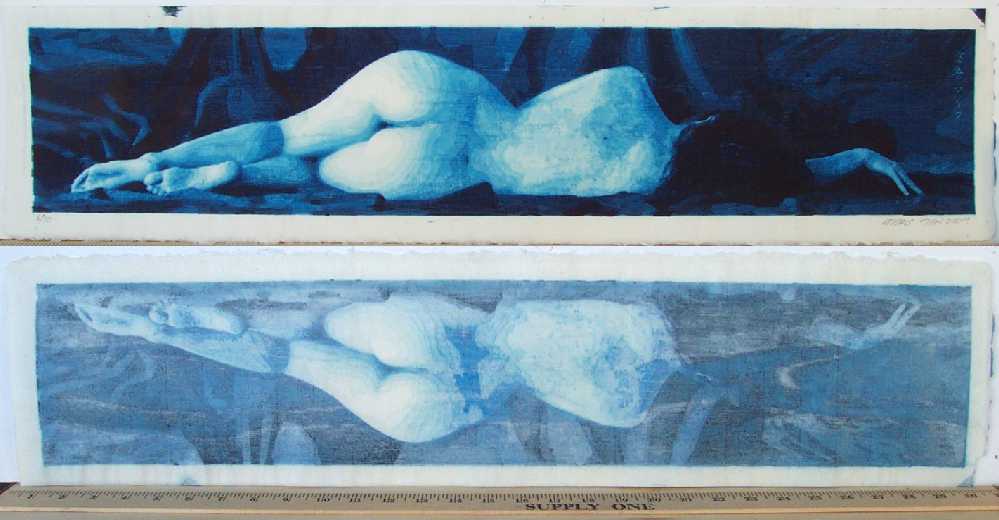
Mike Lyon's Feb 2004 Print, "Jessica Reclining (rear)" (nearly 30-inches wide)
Clearly, much of what Mike Lyon offers to the viewer is that which he himself obviously enjoys viewing.... the female
image. A popular topic of artists over time, feminine beauty has always been admired and thusly become the
topic of many hundreds of artworks over the past centuries. So in this respect, much of "what" Mike's prints show us
is certainly not new. What is NEW, however, is "how" he does it. More about that in a few moments--but first let's
get to know the "man behind the art" a bit better......
A True Dynamo--A Man of Many Interests, Many Talents
Upon meeting Mike, we quickly learned that we were dealing with a very dynamic and energetic individual. When asking
Mike a question, often it seemed that in addition to the immediate reply there would often also be a quick follow-up....
offering additional details or insights. For example, when we asked about the various "artist seals" that Mike was using,
not only did we get the expected short and to-the-point reply. In addition, we also received the
following story in Mike's words about what he calls his "Thunder Mike" seal:
"The (seal's) bottom three characters are 'katakana,' the phonetic characters Japanese people use when they
write 'foreign' words. These are 'ma-i-ku' (pronounced 'ma-ee-koo') which is the way my name, 'Mike,' is usually
written (and spoken) in Japan, and Japanese people recognize it immediately as a 'foreign name.' But I wrote my
family name, 'Lyon,' using two 'kanji' (Chinese characters used to write Japanese text) which can be pronounced a
number of different ways, depending on context."
"In early February 2005 I made a gift of one of my small prints to
Tsutomu Ohshima, perhaps the greatest living master of Shotokan karate. He looked at the print, and then at the
seal for a long time..... squinting and sounding out different ways to pronounce the kanji..... Suddenly he
looked up and his face broke into a happy smile as he had hit upon the correct "rai-on" pronunciation
('rai-on' is a close Japanese approximation of my family name, 'Lyon'.... but 'rai' means 'thunder' and 'on'
means 'sound') and had 'solved' the puzzle -- 'sound-of-thunder-Mike' was really just my name: 'Rai-on Ma-i-ku!!'
Ohshima Sensei told me that it was a clever 'joke' and he seemed to genuinely appreciate it and the print, so
I was very happy."
A few of the various versions of Mike's "seals" are shown just below.
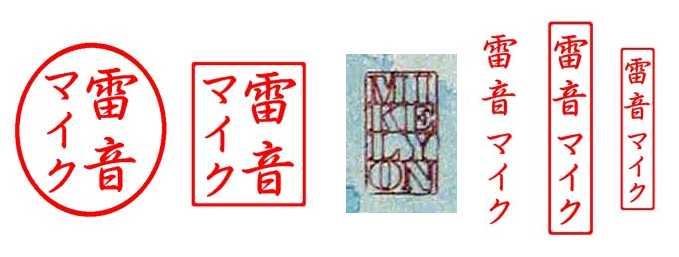
Mike Lyon's various "artist seals," including several versions of his "Sound-of-thunder-Mike" seal
Mike's background and interest in art it seems goes way back to his early childhood. As Mike told us,
"Yes, it always feels good to be liked and admired, (and) that's probably the reason I wanted to be an artist
in the first place (since I was very young -- earliest memories)...
My artwork was my only activity/attribute which seemed consistently to please my Mom and Dad." He tells us that
he's always enjoyed "making things" for as long as he can remember, and when asked as a boy what he wanted to be
when I grew up, his reply was said to always have been either an "alligator," or "fireman," or an "artist!!"
Nevertheless, Mike's continued enthusiasm towards art was certainly not encouraged. Despite having decided by the
time he was in high school that he wanted to be an "artist," an "architect," or a "psychiatrist"--any such talk
of becoming an artist was clearly discouraged by his parents when he expressed any such thoughts out loud about making
a career of it. In Mike's words, he told us "They'd say, 'Think about it for a year, and if you still
want to be an artist, then think about it some more.'" Not exactly the kind of encouragement that leads one
directly into the world of art.
Although lacking the direct encouragement of his parents, in the spring of 1973 Mike received a B.A.
degree in Architecture and Fine Arts from the University of Pennsylvania where his focus was sculpture. In
the fall of that same year he then enrolled in the Kansas City Art Institute where he became a student of
Wilbur Niewald and in 1975 was awarded a B.F.A degree in painting.
As is often the case, however, his parents were right. Despite having received two degrees in art, Mike soon
discovered (at least initially!!) that he was unable to earn a living as an artist. And so, in 1976 he largely
"abandoned" art and joined his father in the cattle hide business that had been started by his great-great
grandfather. Yet, despite the rather mundane-sounding nature of this family business--and recalling Mike's life-long
interest in "making stuff"--to his surprise, he found that the family business still offered a reasonable
opportunity for creativity and invention. And so, in 1978 he started a computer hardware and software design company
which used a series of "touch sensitive" terminals for the grading of cattle hides.
Without getting too far away from Mike's interest in "art," we will simply tell you that during the 1980's Mike
received U.S. patents for two of his inventions (one a "process for purifying water" and a second for a computerized
"order filling system" used by Tupperware and others). Suffice to say, Mike is definitely a hands-on kind of a guy, and clearly also a very
creative individual. Never "to far away" from art in his heart, later in life (as we shall soon learn) Mike
would once again turn to art as his nearly full-time passion and profession.
Wide-ranging, Interests: Karate Instructor, Violin Player, and Woodworker
To quickly illustrate the wide spectrum and dynamic nature of Mike's various interests, we will mention three of
his other passions.
First (and also "Japanese" in nature) is Mike's long-standing interest in karate. Introduced to boxing as a
teenager and "jiyu-jitsu" in 1969 while in college, it was finally in 1984 that Mike undertook a serious study
of martial arts when he became a practicing student of "Shotokan Karate."
Clearly a quick study, Mike quickly earned his "black belt" and in only 4 years time (1988) became appointed the
Midwest Regional Director of Shotokan Karate of America and was then also teaching his "own group" of karate students at the
Kansas City Art Institute. As a result of the disciplines imposed by the study and following of karate, Mike
revealed to us that his "ideas about myself and my place in the world were changing as I continued to practice.
I felt more sure of myself, and more independent." Currently Mike holds Shotokan Karate of
America's second highest rank ("yodan" or 4th degree black belt) and he continues to lead group practices three times
each week at his downtown Kansas City "dojo." (A March 2005 photo of a group Mike led in a three day long
karate "special training" is shown just below.)
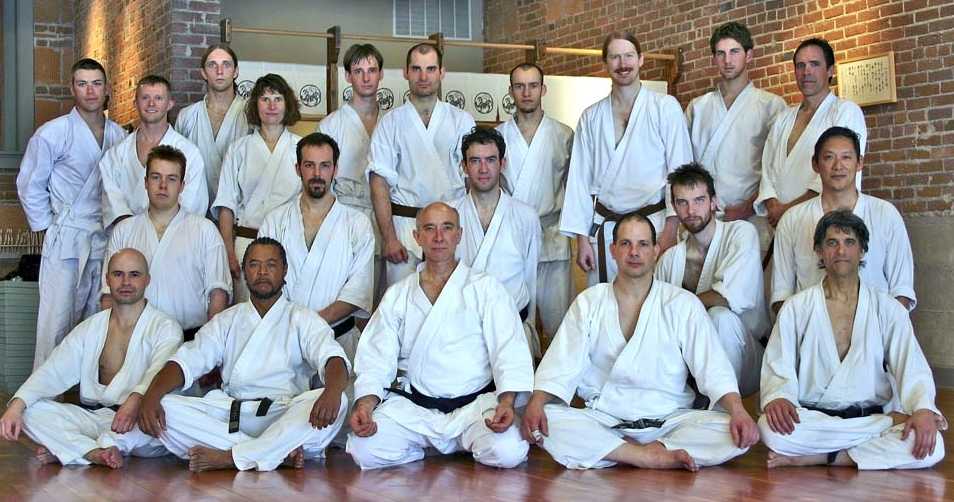
Karate Instructor Mike Lyon (front center), March 2005 after a three-day Special Training
Equally representative of Mike's wide-ranging interests and abilities is that fact that both he and his wife, Linda,
began practicing violin in 1993 and have enjoyed playing "Baroque duets" together ever since. In 2001, on a whim,
they auditioned for the Kansas City Civic Orchestra and ("amazingly," in Mike's own words...) were accepted and have
shared a stand in the 2nd violin section of that orchestra ever since.
One highlight of their tenure with KCCO was when they played before a crowd of more than 20,000 Kansas City's
4th of July SpiritFest, backing up the main event, Dennis DeYoung (the former lead singer of Styx) in his concert there.
As a final example of Mike's diversity of interests, he is also a very accomplished woodworker who both designs and
builds a wide range of wooden objects--ranging from bowls and toys, to flooring, furniture, and even
entire rooms. To appreciate Mike's design talents and obvious woodworking skills, one needs to look no further
than at the two major jobs shown just below.
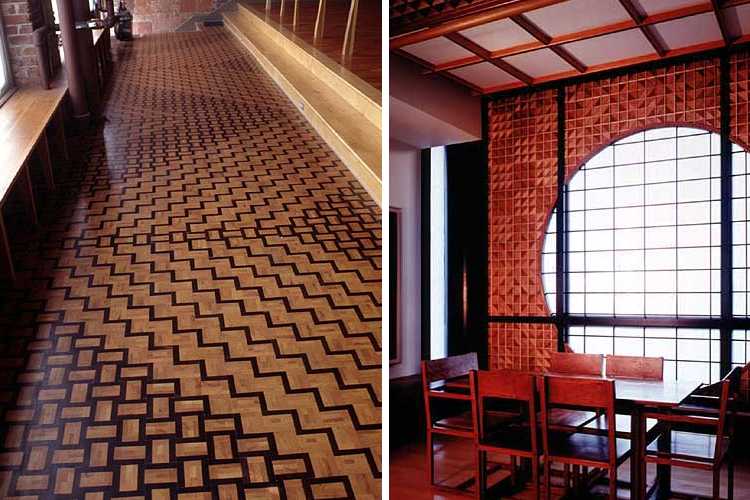
Mike's intricately tiled foyer at the Mike's "Moon Window" Meeting Room at
Kansas City Shotoken Karate Club (1998) Kansas City's UMB Technology Center (1999)
Indeed, it is in Mike's Kansas City Studio where he clearly finds an outlet for this need to design items. Something
deep within Mike clearly drives him to "create"--in his
own words, "I'm an experimenter, an artist, a scientist, an engineer. My need to 'make stuff' is fulfilled in
the studio."
OK then--enough about the many facets of Mike's abilities and interests. Let's now get back to why Mike's "art"
is really the intended focus of this article.
After 15 Years, Mike Lyon Returns to Print-Making
Despite his formal training and degrees earned in art (1973 and 1975 degrees in both sculpture and in painting), Mike soon
learned that directly out of college he was unable to support himself as a working artist. And so, it was not until
much later in life after reaching some significant degree of financial success in the business world that Mike was
again finally in 1991 once again able to fulfill his longing to return to "making art" and to constructively
resume his career as a full-time artist.
Returning to art, much of Mike's work of the early 1990's was spent creating artworks based on his
drawings and photographs, and
include a variety of works from 1993 to 1996 titled "doggies" as well as other comical delights. The period
1993 through 1999 found
Mike involved in a series of lithographs and monotypes, and especially a deep exploration of ways to communicate
image and meaning through simple shapes Mike calls "tiles". A couple of Mike's works of this period (both based on
photographs) are shown just below, including a time-consumingly HUGE 4 x 4 foot portrait of niece "Megan" done in
16-shades-of-grey; it's 9,216 "half-inch squares" each individually hand-painted by Mike over a period
of many days!!
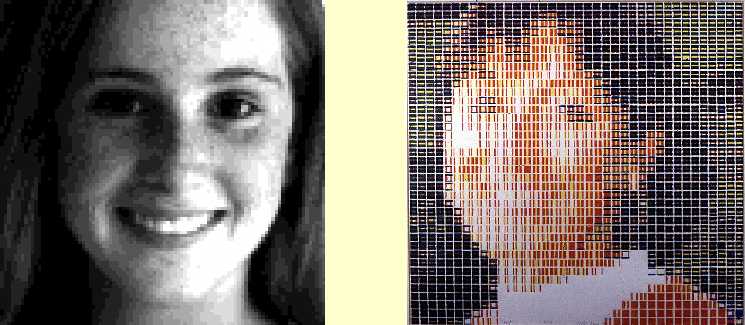
Mike Lyon's 1993 "Megan" (acrylic on canvas, 4 x 4 ft)
1994 "Pat" (4-color tiled plexi-block print, 22 x 22 in)
Eventually, Mike's "tiles" evolved to become the "contours" which he uses to convey his most recent woodcut
portraits and figures.
From mid-1996 throughout 2001 much of Mike's work took on the focus and technique of traditional "moku-hanga"
(Japanese woodblock prints)--although still often of a "comical" nature in their design.
Egotism--A Powerful Force in Art
Interestingly, we discovered, the 1994 to 2000 period also saw the creation of no less than NINE "self portraits" by Mike Lyon.
Why the fascination with "self" one may ask? Is Mike ego-driven or in some way obsessed with himself? In some ways,
perhaps yes.... but is this not often the nature of very artistic or otherwise creative individuals?? Egotism can,
we think, be a very powerful input and driving force in the creation of art. After all, it can take a great
deal of personal courage and confidence to try new things, to think bravely, or to create art in a manner that no one else has ever
attempted before.
Safer..... most artists think...... to simply do what has been done before. Using the same materials and techniques
that have proven to be successful in the past.
On the other hand, true creativity requires no less
than the most steadfast trust and an unshakably deep belief in oneself.
Accordingly--we prefer to simply think of Mike's many self-portraits as perhaps his way of getting to better know
himself..... or should we say, his "inner self?" In any case, these portraits ARE art--and they are at the same time fun!!
One of our favorites is the "green self" seen just below. At least this is apparently how Mike "saw himself" in 2000....
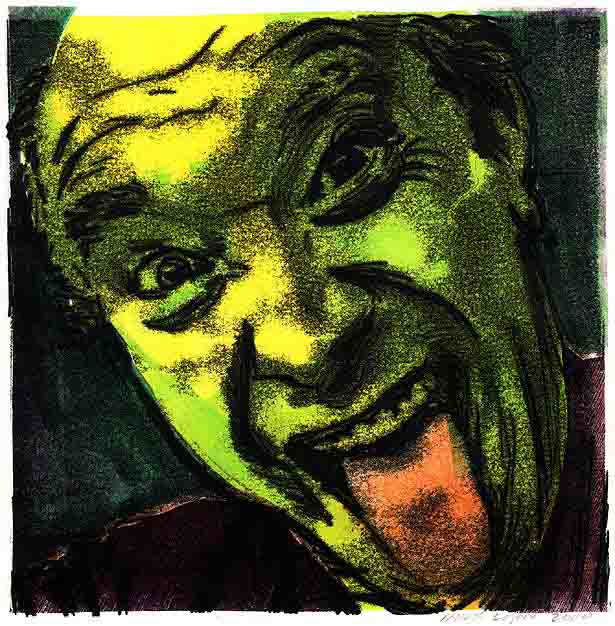
Mike Lyon's green "Rude Self Portrait," 2000 (litho and etching inks on Rives BFK paper, about 11" square)
Of this same "green" self portrait, Mike had the following insightful comments to offer:
"A sculptor friend, David Miller, was in my studio the other day and I showed him the monotype reproduced here.
He said he found it 'quite interesting.'"
"What exactly do you find interesting?" I asked him.
"The fascination you have with your own face!!" he replied.
"Hmmm..... Narcissism, self-involvement, self-centeredness, selfishness, self-absorption. Those all carry a certain
negative connotation, don't they? Reflection, introspection, facing oneself, looking inward. A little more positive?
Know yourself first, then you may come to know others."
"Here I am the way I see me, always my own best model...."
Mike Lyon's Unique Woodblock Print-Making Process -- Post-2002
Already an accomplished photographer, it was in 2002 that Mike's work as an artist finally seems to taken on
a new focus, when he successfully "married" the mediums of both photography AND woodblock printmaking with the creation of the
photographically-based print titled "Music" which is shown just below. (Although it is true that Mike's very first
attempts at blending photography and woodblock printing date to his 1996 print titled "Twins," this earlier print lacked the
"realism" which is clearly evident in his post-2002 prints.)
Additionally, in the process of making his 2002 "Music" print,
Mike also "upped the ante" by
carving each of this print's 15 "different blocks" all from the SAME single block by a process known as
"reduction carving." (We'll explain a bit more about this process in a few moments.)
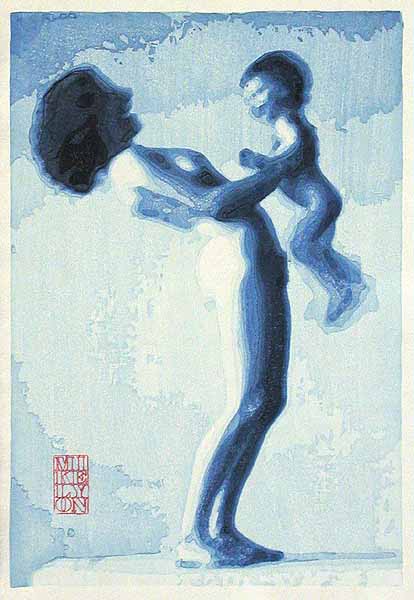
Mike Lyon's 2002 "Music" print, an "aizuri" (shades of blue) print
In any case, nearly all of Mike's woodblock prints from 2002 onwards--some 38 prints by our count--share the
commonality of being inspired by photographs of models that Mike has taken in his studio. Nearly all are also
of nudes or are only partially-clothed. And, the majority of these prints are mono-chromatic, that is, of a single
color--most of them being of a deeply intense Prussian blue.
Quite simply, post-2002 Mike's prints are different: They're bold and they're intense. Yet paradoxically, they're
at the same time also very delicate and soft.
In any case, however one attempts to describe Mike's prints, they're hard to ignore.
They simply grab your attention and demand to be viewed again and again.
The "Reduction Carving" Process
What makes many of Mike's later 38 woodblock prints unique--in addition to the fact that their images are
photographically based--is the process by which they are carved. Traditionally, Japanese woodblock print-making
involves the carving of perhaps a dozen to as many are 25 or 30 different "blocks," with an individual and uniquely
carved block needed for EACH of a print's many colors or various "areas" to be printed.
What makes "reduction carving" unique is that each of the "different blocks" needed to produce a given image are
instead carved, in successive steps, from a SINGLE block of wood. In this manner, various areas of the block's printable surface
are successively "carved away," with a fixed number of "sheets" printed at each step along the way. In this manner, the
remaining "areas" of the uncarved block are repeatedly "inked" and printed such that "these areas" become darker
and darker with each successive over-printing. In other words, the "lightest areas" of the resulting print are
those areas that were "carved away" first.....with the "darkest areas" resulting from the increasingly smaller
areas which are never carved away and receive repeated inkings.
It's a nerve-racking process to produce prints from a SINGLE block in this manner, because if a mistake is made
midway through this multi-step carving AND printing process, there's simply "no going back" and carving "THAT" block
over..... because there is only ONE block to start (and end!!) with. For this reason "reduction carving" is also
sometimes referred to as "suicide carving," since mistakes made midway will ruin the entire run of prints.
Hence, if an artist decides to "reduce" his print's block in 18 carving steps--that is, to produce a final print
of 18 different "shades" of color--and at the same time decides to create an "edition of 30" prints, this means that
30 individual printings
are made at each of the EIGHTEEN carving steps along the way (or a total of 540 printings!!). Doing so is not really
any "less or more work" than if 18 individual blocks were instead carved, but in choosing to use a SINGLE block
it does mean that NO "mistakes" are allowable along the way.
(It's also very important to note that, as a "collector" of prints, the buyer can thusly be GUARANTEED that no
further printings or "editions" will ever be possible of any such "reduction carved" print. That's really what will
make these prints increasingly valued over time--they are unquestionably TRUE "limited edition" prints.)
It's also interesting to observe and note that the very process of "reduction carving" can often give such images
a "distinctive look." Viewed up close, one can often SEE the various "carvings" and "printings," where one color-layer
leaves off and another begins. However, stepping back only a short distance, all of this "layering" seems to disappear.
All that one then sees is a very pleasant, almost "photographic image" (which is, in fact, how these images began in
the first place). In other words, up close on can see and understand "how" the art was produced, while a few steps
back one simply sees only the "art." To see what we've just talked about, take a "close up" look at the same
"Jessica" print (viewed earlier) just below.
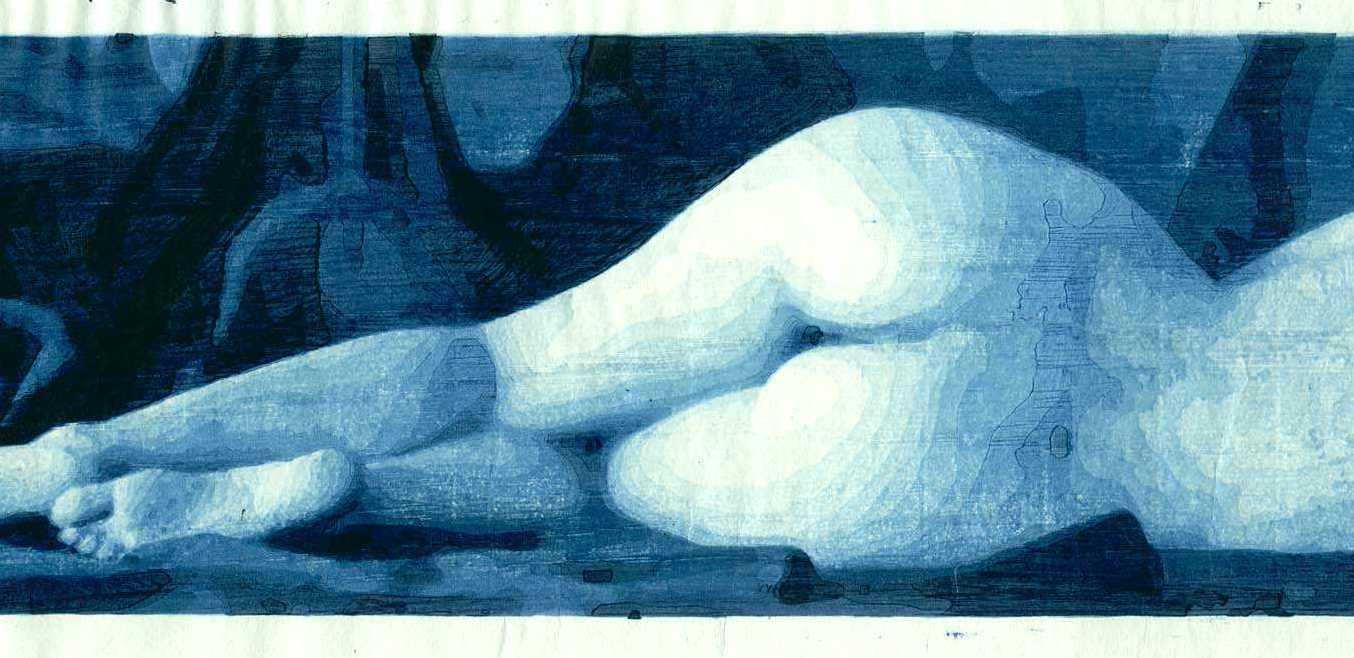
Close-up of Mike Lyon's Feb 2004 Print, "Jessica Reclining (rear)" (note the "color-layering")
Bigger and Bigger, as Mike "Gets By With a Little Help From His Friend..."
During the spring of 2004 Mike--ever the innovator--decided that in order to produce larger and larger prints he had
better get "a little help" with the very time-consuming task of carving the many larger blocks required. Besides, at
already over 50 years of age, his hands were themselves beginning to exhibit signs of "aging" and the pain resulting
from hours and hours of hand-carving began to make Mike think that "there must be a better way." So, in March of 2004
Mike brought in the help of an "assistant" to help him with his carving in order to more quickly achieve the demands
of an increasing output of prints that he sought to produce.
Remember, Mike is an accomplished woodworker--so his "carving assistant" turned out to be a ShopBot CNC
(computer-numerically-controlled) router which can handle the cutting of blocks as large as 48 x 96
inches and can be programmed to tolerances that can follow Mike's drawings to within an accuracy of a
few thousandths of an inch! With the "carving help" of this machine, Mike first produced a small (7 1/2 x 10 inch)
10-block portrait print titled "Max," the success of which he then quickly followed with a much larger 21 x 30 inch, 15-block portrait
print titled "Anthony" which is seen just below.
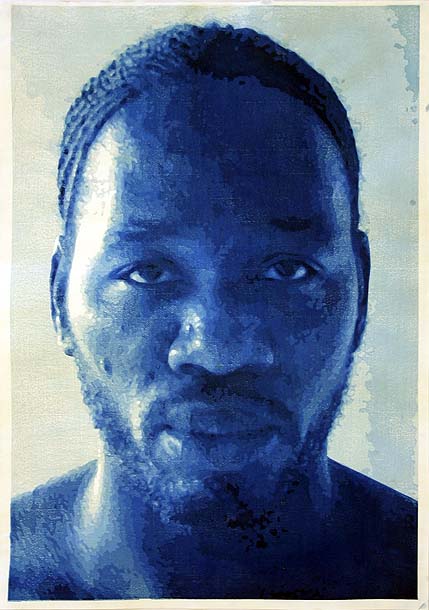
Mike Lyon's April 2004 print, "Anthony" (a LARGE 30 x 21 inch, 15-block print)
(winner of the 2005 McNeese Works on Paper purchase award)
Sure.... some "critics" may attempt to diminish Mike's prints which were carved with the aid of a computer-controlled
router--however, we think that such criticism is both short-sighted and meaningless. Having himself previously HAND-carved
dozens and dozens of blocks, Mike has this observation to make:
"Although I am able to carve much finer
details by hand than I can by using my machine, my machine-carved blocks are superior in some ways to blocks I carve
using hand tools, and I can produce larger blocks much more rapidly. The artistry is really in printing, not
carving although that may be difficult for non-printers to understand..."
To Mike, this use of machine-aided carving is simply faster and saves his hands and time for the much more demanding
task of printing. We will also add that, as Mike pointed out:
"It's important also to realize that the wood that's REMOVED is never
'seen' in the final print.... Instead, it's the wood that REMAINS that creates the visible art. HOW this
unprinted 'waste-wood' is removed is really not relevant to the final art which is produced."
Emotions aside, we certainly find ourselves agreeing with this logic.
Once the machine-aided carving of Mike's blocks is completed, all of the remaining work of printing is again done
by HAND, in the traditional Japanese method. Each individual printing of each block is done by carefully
hand-inking the wood's surface with a small brush, followed by the precise placement of the print's paper against
each of these individual block's raised "kento marks" (precise "registration points"). All of this actual printing is
then done by hand using a traditional bamboo-leafed "baren" printing tool.
We should also point out that Mike makes it a point to use only the finest of Japanese hand-made papers for the
majority of his prints. Most of his prints use paper made for him by Iwano Ichibei (who is recognized in Japan
by having been accorded the status of "Living National Treasure" of papermaking), while some others are printed onto
"hosho" paper made by Yamaguchi Kazuo.
Feeling somewhat liberated from the task of having to hand-carve dozens of blocks, many of Mike's prints of 2004
have as a result gotten bigger--including the three LARGE 21 x 30 inch prints "Anthony," "Sarah," and "Rod" seen
just below. And he talks of even bigger prints to come--currently working on some prints as large as 3 x 6 feet!!
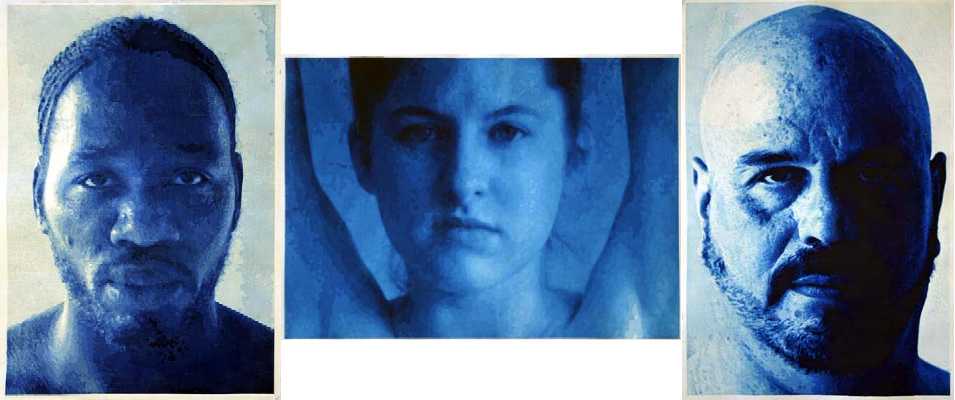
"Anthony" "Sarah" "Rod"
15 cherry plywood blocks 19 cherry plywood blocks 16 cherry plywood blocks
April 2004 May 2004 August 2004
What Others Have Had to Say....
Lately, it seems, the light of recognition has begun to shine quite brightly on Mike Lyon--so much so that his
"Woodblock Printmaking Resume" is now a full page long and has grown to no less than 27 entries including solo and
group exhibitions ranging from Kyoto and Tokyo Japan to Israel, England, Canada and across the entire USA. His
works have also been seen in 6 magazines and other publications.
Perhaps most telling, however, are the words of praise that other fellow artists and art enthusiasts have had to say.
They include the following.
"Visually Mike's 'aizuri-e' prints are stunners. If, as Irving Berlin wrote, 'a pretty girl is like a melody'
then Mike's women are like sonatas and seen collectively are downright symphonic."
(Jerry Vegder -- Ukiyo-e Prints -- Port Townsend, Washington)
"Lyon employs the latest tools and techniques in his production process including digital photography,
electronic image editing, and most recently computer guided cutting tools -- but in the end he produces each
impression by traditional Japanese means -- wood, pigment, paper, rubbing pad, physical exertion, and ultimately
his eye and sensibility."
(John Teramoto, PhD -- Associate Curateor of Asian Art -- Indianapolis Museum of Art)
"Mike's work is wonderful. He has taken a process, relief printmaking, and made it his own. But, one of the
reasons his images are so wonderful is that they 'follow the rules' of good design. He does not neglect the tenets
of good composition, and though he often works monochromatically he uses God only knows how many tints and tones
to reach a full range of values. The manipulation of space and form are considerations, and although his recent
work is 'photographic' in nature it is not the same as a photograph. (I make that distinction to distance it
from photo-realism of which I am not a fan, I have a 'why bother?' kind of attitude on that one.) And last,
but not least, the pose of the model creates the most wonderful fluid line."
(Sharri LaPierre -- Bare Bones Studio -- Vancouver, WA)
"I am amazed how these images that could simply be commonplace and ordinary become truly unique works of art
through Mike. I feel I have encountered a man and his work from whom great things can be expected for a long time
to come."
(Go Yamao -- Gallery Ezoshi -- Kyoto, Japan)
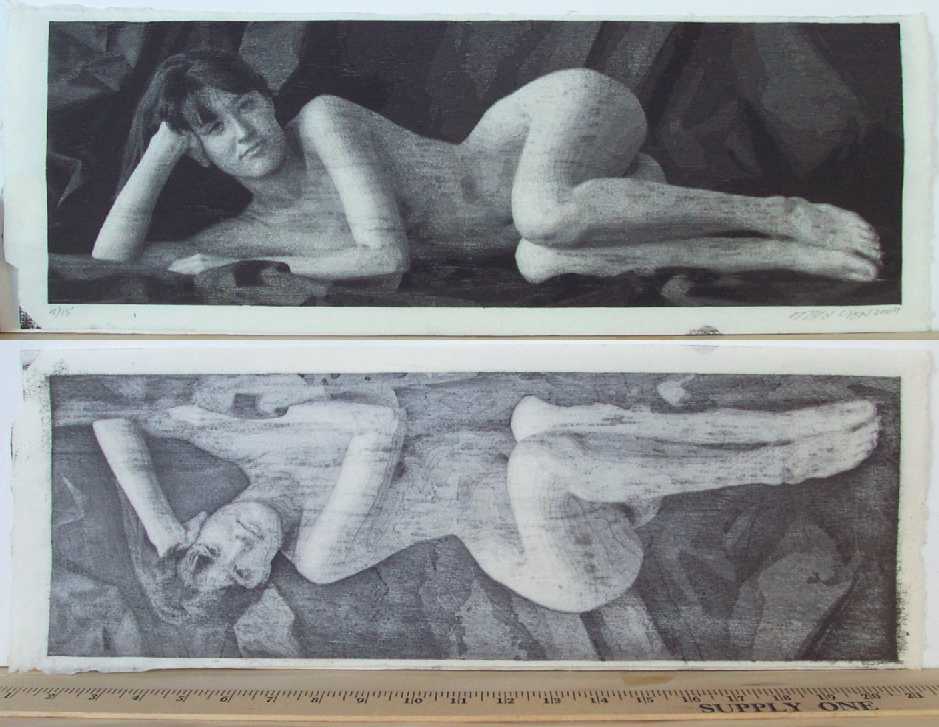
Mike Lyon's Feb 2004 Print, "Jessica Reclining (facing)" (6 3/4 x 20 3/8 wide)
A Word about Mike Lyon's Truly "Limited Editions"
One thing that collectors of Mike Lyon's prints have working strongly in their favor is the very limited sizes of Mike's
typical editions. Some of Mike's prints are produced in edition sizes as small as only 10 to 12 prints, with a
typical "large edition" running usually only 20 to 30-some prints. More importantly, however--due to the "destructive"
nature of the successive carving of a single block, collectors are insured that once the initial "edition" is completed
of a "reduction carved" print that NO future editions can ever be produced.
Conclusion and an Afterthought....
Not only do we like Mike's prints, we're also very optimistic about what the future holds for Mike Lyon's works, as
he seems to have certainly found success as an independent print-maker.
To collectors of Japanese woodblock prints, the prints being produced by Mike Lyon are both noteworthy and
certainly deserving of their attention.
A selection of Mike Lyon's prints are now available in our Ukiyoe-Gallery website's
Gallery #4.
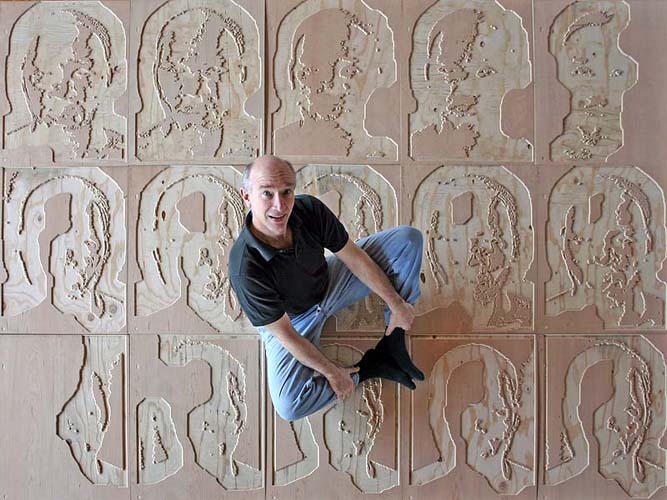
Mike Lyon sitting atop the 15 blocks of his 2004 print, "Anthony"
Literature (and print) sources used in preparation of this and other articles include:
Prints courtesy of: Ukiyoe-Gallery and Mike Lyon & Lyon Art, Ltd.
Photos courtesy of: Mike Lyon & Lyon Art, Ltd.
Photo of: "Mike Lyon in front of 'Sarah'" courtesy of April Vollmer
"Guide to Modern Japanese Woodblock Prints: 1900-1975", by Helen Merritt and Nanako Yamada, University of Hawaii Press, Honolulu, ISBN 0-8248-1732-X
"Kawase Hasui -- The Complete Woodblock Prints", by Kendall H. Brown & Shoichiro Watanabe, Hotei (KIT) Publishing, Netherlands, ISBN 90-74822-46-0
"Crows, Cranes and Camellias: The Natural World of Ohara Koson", by Amy Reigle Newland, Jan Perree, Robert Schaap, Hotei (KIT) Publishing, Netherlands, ISBN 90-74822-38-X
(c) Thomas Crossland and Dr. Andreas Grund, May 2005
Gallery
Terms
Ordering
About Us
We Buy Prints
Library
